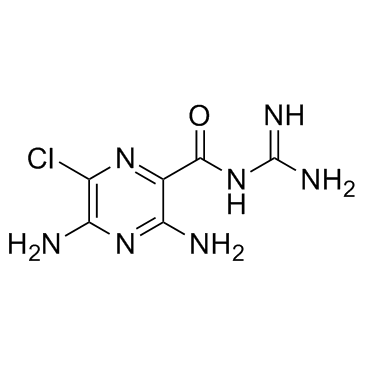| Description |
Amiloride is a relatively selective inhibitor of the epithelial sodium channel (ENaC), used in the management of hypertension and congestive heart failure.
|
| Related Catalog |
|
| Target |
Sodium channel
|
| In Vitro |
Amiloride blocks δβγ channels with an IC50 of 2.6 μM (58, 71, 75, 134, 148). The Ki of amiloride for δβγ ENaC is 26-fold that of αβγ channels (0.1 μM for αβγ ENaC). Amiloride blockade of δβγ ENaC is much more voltage dependent compared with the αβγ channel. The Ki of amiloride for δαβγ channels is 920 and 13.7 μM at -120 and +80 mV, respectively, which significantly differs from that of both αβγ and δβγ channels[1]. Amiloride is a relatively selective inhibitor of the epithelial sodium channel (ENaC) with an IC50 (the concentration required to reach 50% inhibition of an ion channel) in the concentration range of 0.1 to 0.5 μM. Amiloride is a relatively poor inhibitor of the the Na+/H+ exchanger (NHE) with an IC50 as low as 3 μM in the presence of a low external [Na+] but as high as 1 mM in the presence of a high [Na+]. Amiloride is an even weaker inhibitor of the Na+/Ca2+ exchanger (NCX), with an IC50 of 1 mM. Amiloride (1 μM) and submicromolar doses of Benzamil (30 nM), doses known to inhibit the ENaC, inhibit the myogenic vasoconstriction response to increasing perfusion pressure by blocking the activity of ENaC proteins. Amiloride completely inhibits Na+ influx in doses known to be relatively specific for ENaC (1.5 μM) in vascular smooth muscle cells (VSMC)[2].
|
| In Vivo |
Amiloride (1 mg/kg/day) subcutaneously is found to reverse the initial increases in collagen deposition and prevent any further increases in the DOCA-salt hypertensive rat. Amiloride delays the onset of proteinuria and improved brain and kidney histologic scores in the saline-drinking, stroke-prone spontaneously hypertensive rats (SHRSP) compared with controls. Amiloride antagonizes or prevents actions of aldosterone in these cells and in cardiovascular and renal tissues in animals with salt-dependent forms of hypertension[2].
|
| References |
[1]. Ji, H.L., et al. delta ENaC: a novel divergent amiloride-inhibitable sodium channel. Am J Physiol Lung Cell Mol Physiol, 2012. 303(12): p. L1013-26. [2]. Teiwes J, et al. Epithelial sodium channel inhibition in cardiovascular disease. A potential role for amiloride. Am J Hypertens. 2007 Jan;20(1):109-17.
|
